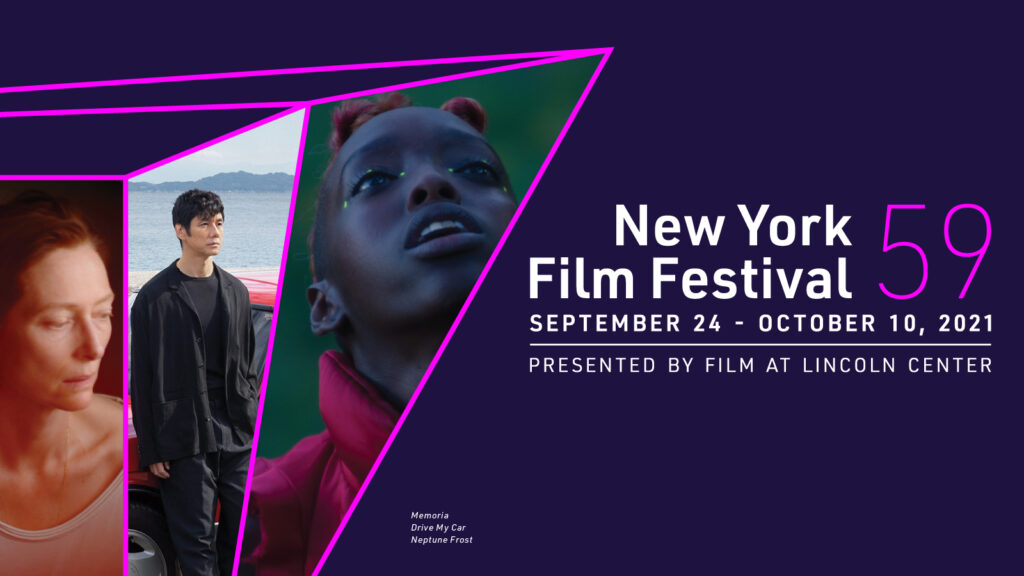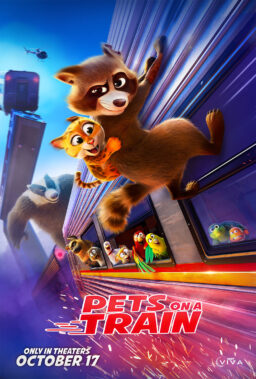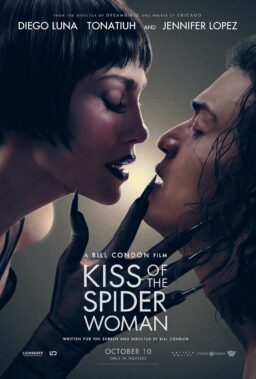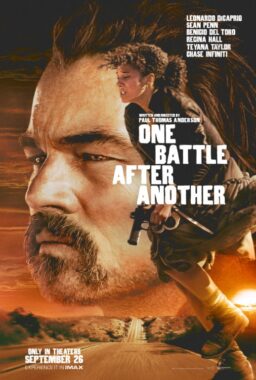Arriving at the end of its sixth decade, the New York Film Festival exhibits the wary tentativeness of a patient waking up after a lengthy operation. Are my legs still here? My arms? Can I raise my head? Sit up? Fortunately, the answers in all cases turns out to be yes. But the patient will be advised to take it easy. No jumping jacks just yet. Baby steps first.
Which is to say, metaphorically, that the NYFF is back, but still feeling the after-effects of the pandemic that reduced it and most film festivals around the world to a spectral “virtual” existence—if that—during 2020. Over the summer, during those happy couple of months when it seemed that the Covid-19 virus might be making a rapid exit, one could imagine that the Fall would bring a festival completely returned to its status quo. The upsurge of the delta variant in late summer, though, put the brakes on those rosy expectations, such that the 59th NYFF ends up in something of an in-between state—up and running, but cautiously so.
For both the press and the public, this means proof of vaccination and mask wearing, but with the public returning to the festival’s accustomed venues at Lincoln Center. At the press screenings I attended, no concessions were sold and even water and coffee from outside were disallowed, as announcements at every screening sternly advised. While these minor inconveniences were easily accepted, it seemed to me that the numbers of people attending the screenings were less than in pre-pandemic times, perhaps because any critics still wary of entering the Walter Reade Theater in many cases have the option of watching films at home, via screener links. Having watched every film I reported on last year that way, I was glad to be watching this year’s films up on the big screen, surrounded by other cinephiles, even without coffee.
Other major 2021 festivals that occurred before the NYFF—Venice, Telluride, Toronto—did so with all the familiar protocols in place and encountered few problems, either in terms of attendee pushback or resultant viral surges. In terms of programming, the resurrected festival that had the most impact on New York was, of course, Cannes. When the taste-making French festival was canceled in 2020, it left New York and other festivals without the pipeline of new arthouse favorites that usually fill their programs. Having long found the NYFF’s reliance on Cannes’ lead excessive, I regretted not seeing more independence and idiosyncrasy in last year’s programming, which I called undernourished.
This year, the nourishment was back, in the form of a return to a reliance on French precedent. Nearly two-thirds of the NYFF’s Main Slate are films that launched at Cannes. In part, this was as beneficial as it was expected: With many films backlogged from 2020 added to those finished in 2021, the Cannes programmers had a bountiful crop to choose from, and their highlights—the good, the fashionable and the dubious—were duly passed along to New York.
As usual, this means a preponderance of auteur films from countries that the NYFF has traditionally favored. Rather surprising was the relatively small number of French titles, as well as the proclamation of a “resurgent” Italian cinema that wasn’t backed up by any particularly impressive on-screen evidence. As in the past, the NYFF’s selection committee—led by festival director Eugene Hernandez and programming director Dennis Lim—made a few quirky departures from the French party line. Asghar Farhadi’s “A Hero” was one of the most acclaimed films at Cannes, but it’s nowhere in the lineup at the NYFF, which hasn’t shown a film by the double-Oscar-winning Iranian since 2011’s “A Separation.”
In recent years, very few films in the NYFF have been premieres, and the auteurs represented have almost always seen their films debut at other festivals. In 2021, for example, the Cannes veterans include Americans Wes Anderson (“The French Dispatch”) and Todd Haynes (“The Velvet Underground,” a doc) as well as the makers of the festival’s Centerpiece film, Jane Campion’s “The Power of the Dog,” and Closing Night film, Pedro Almodovar’s “Parallel Mothers.”

Opening Night, then, is currently the only major slot reserved for a premiere, but in that regard, the 2021 NYFF is off to a grand start, because Joel Coen’s “The Tragedy of Macbeth” turns out to be a terrific film that’s ideally suited to its place in the festival’s lineup. Not only is it a resounding success by a major New York filmmaker (or two if we include Coen’s wife and the film’s producer/star, Frances McDormand), but it’s also a film that evokes the art-film heritage long championed by the New York Film Festival.
I say that in part because of the film’s look. Working for once without his brother and longtime collaborator Ethan, Joel Coen has fashioned a gorgeously imagined vision of Shakespeare’s Scotland, filmed in austere black and white with an Academy aspect ratio and production design that’s dazzlingly distinctive while also calling to mind a whole host of cinematic precedents. Many of those harken back to the German Expressionists, and almost my first thought on witnessing them was that this was a film that F.W. Murnau might have imagined. But as soon as that impression settles in, you begin to sense comparisons to the work of other directors in the same lineage, from Dreyer to Bergman and Peter Brook.
This is anything but a showy display of cinephilic knowingness. It’s a rich and original conjuring that provides a sensual equivalent to the textures and angles of Shakespeare’s violent drama, and indeed unifies many of the play’s divergent moods and movements. Whether in the moors where the Weird Sisters declaim their cryptic prophecies, on the battlefield where Macbeth (Denzel Washington) and Banquo (Bertie Carvel) deliver their news of victory to ill-fated King Duncan (Brendan Gleeson), in the castle where the gruesome murders are committed and Lady Macbeth (McDormand) later walks in a guilty trance, or in any number of eerily remote and threatening landscapes, the film gives us a world with its own harsh and encompassing dream logic. The work of cinematographer Bruno Delbonnel, production designer Stefan Decant, composer Carter Burwell and others contribute mightily to this world’s enrapturing power.
The stylistic tour de force’s way of unifying the film’s various elements extends even to its cast, which is diverse in the usual sense and others too. Besides Washington, there are other Black actors, as well as Brits performing alongside Americans and theater actors working with those more used to film or television. In the film’s press conference, all the actors interviewed credited an unusually generous three-week rehearsal time for their ability to forge a group sensibility in approaching the play’s challenges and Coen’s overarching vision.
Doubtless, the younger actors were inspired and instructed by Washington and McDormand, who are simply superb in their roles. While both actors have plenty of Shakespeare in their resumes, their performances here surely represent a career peak. At their press conference, Dennis Lim pointed out that Kenneth Tynan wrote the characters for Polanski’s “Macbeth” as being in their 20s, an age when they might be gripped by overweening ambition. Washington and McDormand, both in their mid-60s, replied that they envisioned the couple as having missed too many opportunities in the past and now desperately lunging for their last chance.
That makes perfect sense, and adds an element of poignancy to the brutal velocity of Shakespeare’s plunge into royal murder and madness. Other fine films have, of course, have been made from this material, but I have a feeling that Coen’s film will end up being judged equal or superior to any of them. It’s truly one for the ages.

Other Early Winners
In the festival’s first week of press screenings, I saw a mix of films that created the same impression that I come away with every year. A couple seem so ordinary that you can’t imagine how they made into to such a select company. Others are good and very much deserving of their place in the festival, but not strikingly exceptional. Then there are the real stand-outs, films that easily qualify as among the year’s best. Here are four that add an element of greatness to this year’s festival.
“Drive My Car”
When theater director Yusuke (Hidetoshi Nishijima) arrives in Hiroshima to stage Uncle Vanya, he requests lodging an hour away from the theater so he can indulge his penchant for learning a play’s text by listening to a tape on long drives in his red Saab 900. But there’s a problem: past difficulties have made the theater decree that guest artists must have drivers. So Yusuke is entrusted to the care of Misaki (Toko Miura), a young, poker-faced chauffeur who knows nothing of Chekhov but senses in her charge a fellow damaged soul: while he is still stricken by the death of his beautiful, unfaithful wife, the driver mourns her abusive mother, whom she failed to rescue from an landslide. There are other characters and complications woven into this set-up; the three-hour film has an expansive scope and a pensive, generous way of unfolding its narrative. And the themes are hardly unfamiliar. Yet if the difficulties overcoming struggles with guilt and grief have been dramatized often in recent years, the filmmaking talent assembled here accomplishes the tricky task of avoiding the inherent melodramatic pitfalls and delivering a penetrating drama that has extraordinary cumulative power. Ryusuke Hamaguchi’s film is adapted from a story by Haruki Murakami.
“The Worst Person in the World”
Judged just by its premise and main concerns, this Norwegian film can sound like too many other movies—especially a whole raft of American indie works, not to mention TV shows—that deal with the vicissitudes of contemporary young people trying to negotiate the trials of love, work and indecision. Julie (Renate Reinsve) is 29, with a boyfriend, Aksel (Anders Danielsen Lie), who’s 15 years older. He’s settled in his profession as a successful satiric cartoonist. She starts out thinking she wants to work in medicine, then shifts to psychology, then photography. Yes, she’s a bit of a ditz—and not the worst person in the world; that’s someone else—but the film never treats her condescendingly. In fact, writer-director Joachim Trier has a gift for treating such people with nuance, sympathy and insight. The result here is a tale that’s almost too rich to be pigeonholed as a romantic comedy. It ranges over several years and a number of life changes for its characters, and at every turn in the journey it seems to grow richer and more penetrating, even to the point of discovering the tragic dimension beneath its comedic surface. Distinguished by the fine performances by its leads, it’s a brilliantly mounted film that seems destined to be one of the year’s big arthouse hits.
“Bad Luck Banging or Loony Porn”
As crazily offbeat as its title, this winner of the Golden Bear at Berlin this year begins with an entirely X-rated scene in which a couple engages in an exuberant bout of copulation while videotaping their exertions. Their bit of homemade porn then accidentally makes its way to the Internet and has a drastic impact on the career of the woman, a middle-school teacher. Made by Romanian director Radu Jude, this high-energy satire not only manages to touch on an amazing number of contemporary discontents—about politics, religion, morality, media, hypocrisy, and much else—but also makes you realize how the same concerns that animate and polarize people whose kids go to a certain Bucharest middle school seem to be sparking social divisions the world over. This is also one of several films in the festival that show people wearing masks against the pandemic—which only adds to its air of contemporary authenticity and disquiet.
“Prayers for the Stolen”
Confirming the promise of her documentary feature “Tempestad” (see my review), this first dramatic film by Mexican director Tatiana Huezo demonstrates her formidable skills as both a gifted and original cinematic stylist and a chronicler of the hardships of impoverished Mexican and girls caught up in Mexico’s current civil turmoil. The main character here, Ana, is a girl whose family lives in a mountain village where they pick poppies for the drug trade. Much of what Huezo shows us initially is lyrical and observant, almost in documentary fashion: the rhythms of life in the verdant setting and the bonds that unite Ana with her friends and their moms (dads are mostly away in the U.S. working). The dangers that threaten them, especially cartels that steal girls to sell them into bondage, almost seem like abstractions—until they suddenly explode into view. A poignant, wise and beautifully crafted drama, Huezo’s latest promises great things to come.
“The Bloody Child”
Though her work may be classified as experimental, Los Angeles-based filmmaker Nina Menkes is perhaps best described as a visionary poet of cinema. In its Revivals section, this year’s festival includes a new restoration of her third feature, a hallucinatory, multi-leveled exploration of the physical and psychic resonances of a crime: a Gulf War veteran is arrested while digging a grave in the desert for his wife, whom he has apparently murdered. While touching on challenging emotional and political issue, Menkes’ way with cinematic language is unique and exhilaratingly original. Not to be missed.












